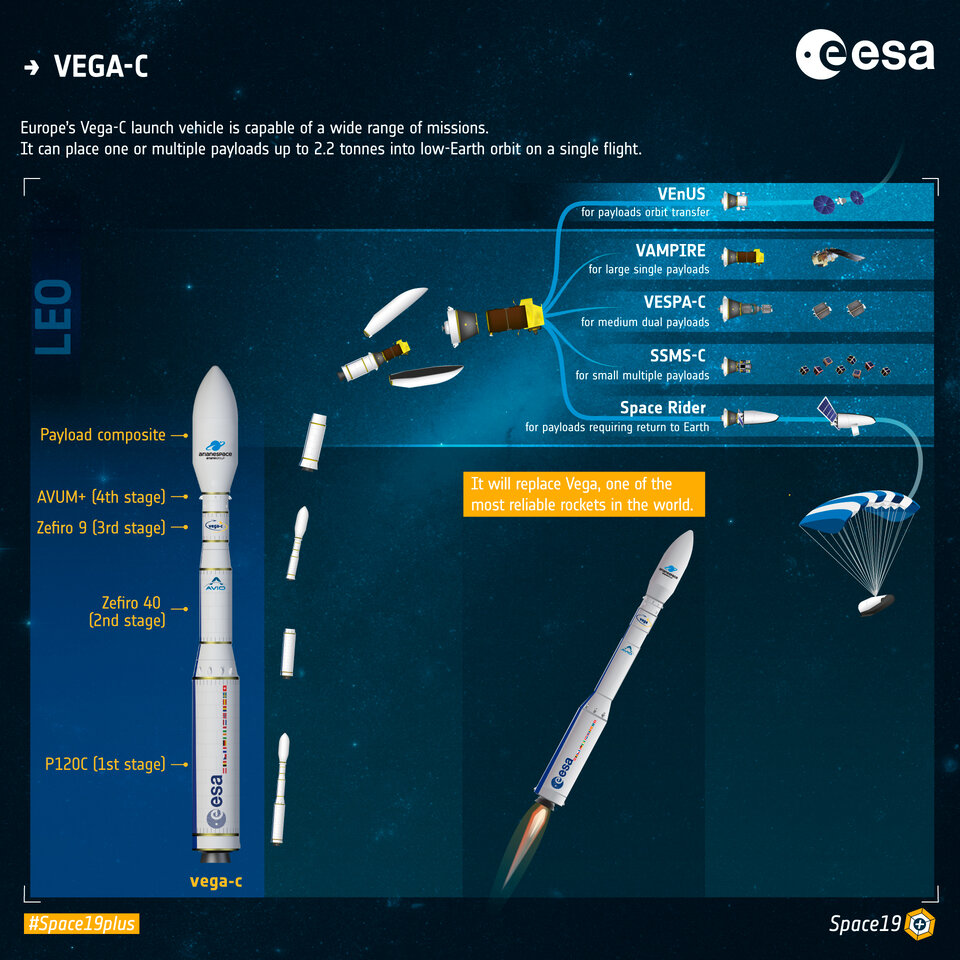NOTE - After liftoff please do the gravity turn slowly because the rocket is pretty unstable sometimes, also this is my first time trying to recreate a replica, so might not be the good size and stuff but i hope y'all like it, if you did don't forget to leave an upvote !!
Some Info abot the rocket :
Vega-C is a single body rocket about 35 m high with a mass at liftoff of 210 tonnes. It is able to place about 2200 kg in a reference 700 km-polar orbit. This will meet the needs of European institutions and industry.
Using a new range of payload carriers, Vega-C will be able to accommodate cargo of different shapes and sizes ranging from multiple small satellites as small as one kilogram up to a single large payload.
Participating States in Vega-C development are: Austria, Belgium, Czech Republic, France, Germany, Ireland, Italy, Netherlands, Norway, Romania, Spain, Sweden and Switzerland.
Vega-C elements :

Vega-C is based on the existing Vega launch vehicle. It comprises four stages: three solid propellant stages, an upper fourth stage powered by a reignitable liquid-propellant engine, and a payload fairing.
The ogive-shaped fairing at the top of Vega-C is 3.3 m in diameter and over 9 m tall. Made of carbon fibre-polymer composite and ‘cured’ in an industrial oven, this structure protects satellites from the thermal, acoustic, and aerodynamic stresses at liftoff and on the ascent to space.
The upper stage AVUM+, or Attitude Vernier Upper Module, ensures attitude control and precise orbital positioning and is designed for extended stays in space. The AVUM+ has a propellant mass of 0.74 t and the main engine will provide an average thrust of 2.45 kN. The reignition capability of the AVUM+ allows Vega-C to reach a range of orbits to deliver multiple payloads on a single mission. Thrusters will typically burn one, two or more times to reach the required orbits. After separation of the payload(s), there will be a final boost to deorbit the upper stage, so that it burns up high in Earth's atmosphere over the ocean.
The third stage Zefiro-9, derived from Vega, burns 10 t of solid propellant.
The second stage powered by the new Zefiro-40 (Z40) motor contains about 36 t of solid propellant, providing an average thrust of 1100 kN.
The first stage P120C motor is one of the largest monolithic carbon-fibre solid-propellant rocket motors ever built in one piece. Its development relies on new technologies derived from those of P80, the current first stage motor of Vega, to provide a significant increase in thrust at liftoff. The P120C will also be used as the side boosters on the Ariane 6 rocket, creating an opportunity for Europe to scale up production by using it on two launch vehicles in parallel.

CREDITS for the satellite goes to : TankeryAerospace
Controls : AG1 + Slider 1 : Satellite extend
GENERAL INFO
- Created On: Windows
- Game Version: 0.9.601.0
- Price: $184,918k
- Number of Parts: 389
- Dimensions: 68 m x 7 m x 7 m
PERFORMANCE
- Total Delta V: 32.4km/s
- Total Thrust: 71.0MN
- Engines: 8
- Wet Mass: 5.26E+5kg
- Dry Mass: -290,474,513,743,741,000kg
STAGES
| Stage | Engines | Delta V | Thrust | Burn | Mass |
|---|---|---|---|---|---|
| 1 | 1 | 2.2km/s | 8.3MN | 1.5m | 5.26E+5kg |
| 2 | 0 | 0m/s | 0N | 0s | 1.4E+5kg |
| 3 | 1 | 29.0km/s | 3.0MN | 2.0m | 1.4E+5kg |
| 4 | 1 | 737m/s | 1.7MN | 23s | 60,943kg |
| 5 | 1 | 390m/s | 267kN | 19s | 13,773kg |
No Comments
2 Upvotes
Log in in to upvote this post.








